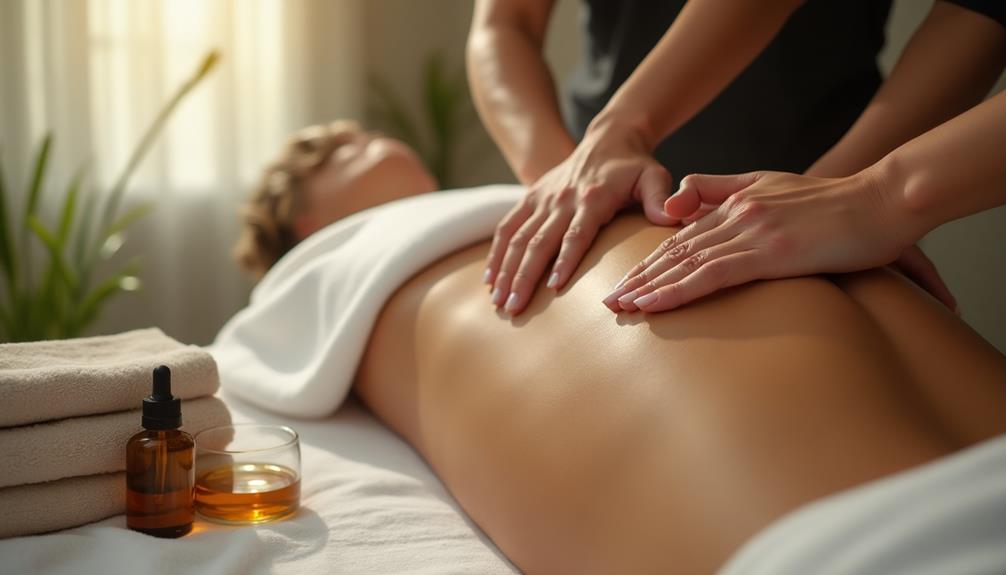To heal muscles effectively after training, consider these seven essential techniques. First, focus on proper nutrition—consume lean proteins and healthy fats to aid recovery. Second, stay hydrated, aiming for 8 to 10 ounces of water per hour. Third, incorporate active recovery, like low-intensity exercises, to enhance blood flow. Fourth, practice stretching, using dynamic stretches pre-workout and static stretches after. Fifth, explore massage therapy for better blood circulation and tension relief. Sixth, employ cold and heat therapy to manage inflammation and relax muscles. Lastly, prioritize sleep and rest management for best recovery. There's more to explore on this topic.
Core Insights
- Incorporate proper nutrition with lean proteins, healthy fats, and whole grains to support muscle recovery and energy replenishment.
- Stay hydrated by drinking 8 to 10 ounces of water per hour during exercise and using electrolyte drinks for prolonged activities.
- Utilize active recovery techniques like low-intensity exercises to promote blood flow and reduce muscle stiffness post-workout.
- Implement stretching routines, including dynamic stretches before workouts and static stretches afterward, to enhance flexibility and range of motion.
- Consider massage therapy to increase blood circulation, alleviate muscle tension, and enhance overall performance through tailored techniques.
Proper Nutrition

Proper nutrition plays a pivotal role in your muscle healing journey as an athlete. To start, focus on incorporating lean proteins into your meals. Proteins provide the essential amino acids your body needs to repair muscle tissue. Consider options like chicken, fish, beans, and tofu. While nutrition is key, some athletes may also benefit from fat burning supplements to support their overall fitness goals. These supplements can complement a well-balanced diet and aid in recovery.
Next, don't underestimate the power of healthy fats. Foods like avocados, nuts, and olive oil can reduce inflammation and support recovery.
Carbohydrates are also essential; they replenish your energy stores after workouts. Opt for whole grains, fruits, and vegetables, which offer vitamins and minerals to enhance healing.
Hydration Strategies

Aim for at least 8 to 10 ounces of water every hour of exercise. If you're engaging in intense activities lasting over an hour, consider electrolyte drinks to replenish lost minerals. For peak performance, hydration powders can be an effective alternative to traditional sports drinks, offering customized electrolyte replenishment.
Pay attention to your body's signals; thirst is a clear indicator that you need more fluids. You can also monitor your urine color—light yellow means you're well-hydrated.
Active Recovery Techniques

Staying hydrated sets the stage for effective recovery, and incorporating active recovery techniques can further enhance your muscle healing. Active recovery involves low-intensity exercises that keep your body moving while allowing your muscles to recover. Proper hydration is essential, especially during hot weather, and salt pills can help maintain electrolyte balance during intense workouts and recovery periods.
Engage in activities like walking, cycling, or swimming to promote blood flow and reduce muscle stiffness. These exercises help flush out lactic acid and deliver necessary nutrients to your muscles.
Aim for 20 to 30 minutes of active recovery after intense workouts. You can also consider light yoga or mobility drills to maintain your range of motion.
Stretching and Flexibility

Here's a simple guide to help you:
| Type of Stretch | When to Use | Benefits |
|---|---|---|
| Dynamic Stretching | Pre-workout | Warms up muscles, enhances performance |
| Static Stretching | Post-workout | Increases flexibility, reduces soreness |
| Foam Rolling | Anytime | Relieves muscle tension, improves blood flow |
| Active Stretching | During workouts | Engages muscles, improves balance |
Massage Therapy

After focusing on stretching and flexibility, it's important to contemplate how massage therapy can further enhance muscle recovery for athletes. Massage therapy works by increasing blood flow to the muscles, which promotes healing and reduces soreness. It helps in breaking down scar tissue and alleviating muscle tension, making it an essential tool in your recovery arsenal.
There are various techniques you can explore, such as deep tissue massage, sports massage, or trigger point therapy. Each technique targets specific areas of tightness and discomfort. Incorporating regular massage sessions into your routine can significantly boost your performance and overall well-being.
Don't forget to communicate your needs with the therapist, ensuring they tailor the session to your specific muscle recovery goals.
Cold and Heat Therapy

Cold and heat therapy are two effective methods for enhancing muscle recovery in athletes.
Cold Therapy
When you apply cold compresses or ice packs, you reduce inflammation and numb sharp pain. This method is particularly helpful right after an injury. Aim to use it for 15-20 minutes every couple of hours.
Heat Therapy
On the other hand, heat therapy improves blood flow and relaxes tight muscles. You can use warm towels or heating pads for this. It's best to apply heat on sore muscles after the initial swelling has gone down, usually 48 hours post-injury.
Combining Techniques
For optimal recovery, consider alternating between cold and heat. This combination can maximize healing and restore your strength effectively.
Sleep and Rest Management

Consider creating a relaxing bedtime routine. Activities like reading or stretching can signal your body that it's time to wind down.
In addition to sleep, prioritize rest days in your training schedule. These breaks prevent overtraining and reduce the risk of injury.
Listen to your body; if you're feeling fatigued, take a step back. Incorporating effective sleep and rest management into your routine will ultimately enhance your athletic performance.
Frequently Asked Questions
How Do Psychological Factors Affect Muscle Healing in Athletes?
Psychological factors, like stress and motivation, greatly influence your muscle healing. When you're positive and focused, your body tends to respond better, enhancing recovery. However, negative emotions can hinder your healing process and prolong recovery time.
What Role Does Supplementation Play in Muscle Recovery?
Think of supplementation as your secret weapon in recovery. It boosts muscle repair, enhances performance, and reduces soreness. By incorporating the right nutrients, you're giving your body the support it needs to bounce back faster.
How Can Athletes Identify Overtraining Symptoms?
You can identify overtraining symptoms by paying attention to increased fatigue, irritability, sleep disturbances, and declining performance. If you notice these signs, it's essential to rest, reassess your training, and adjust your recovery strategies.
Are There Specific Injuries That Require Different Healing Techniques?
When it comes to injuries, one size definitely doesn't fit all. You'll find that different injuries like strains or sprains need tailored approaches. Recognizing the specific injury helps you choose the best healing technique.
How Does Age Influence Muscle Healing Rates in Athletes?
Age greatly affects your muscle healing rates. As you get older, your body's recovery slows down due to decreased circulation, lower hormone levels, and reduced muscle mass, making it essential to adjust your rehabilitation strategies accordingly.

